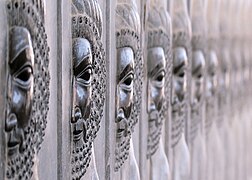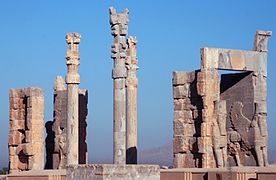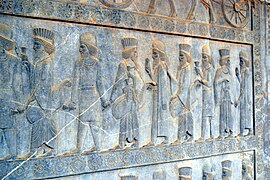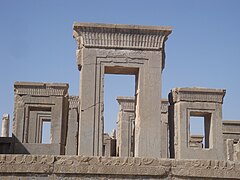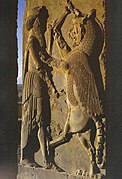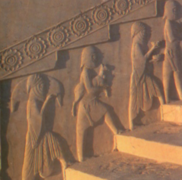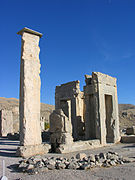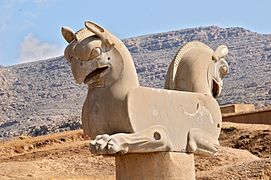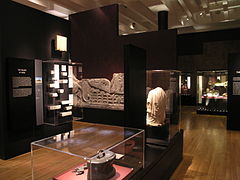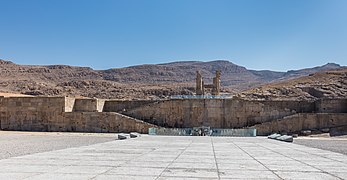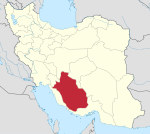Persepolis
This article contains too many pictures for its overall length. (January 2024) |
| |
 Gate of All Nations in Persepolis | |
 | |
| Location | Marvdasht, Fars Province, Iran[1] |
|---|---|
| Coordinates | 29°56′06″N 52°53′24″E / 29.935°N 52.890°E |
| Type | Settlement |
| History | |
| Builder | Darius I, Xerxes I and Artaxerxes I |
| Material | Limestone, mud-brick, cedar wood |
| Founded | 6th century BC |
| Abandoned | 330 BC |
| Periods | Achaemenid Empire |
| Cultures | Persian |
| Events |
|
| Site notes | |
| Condition | Ruins |
| Management | Cultural Heritage, Handicrafts and Tourism Organization of Iran |
| Public access | Open |
| Website | persepolis.ir |
| Architecture | |
| Architectural styles | Achaemenid |
| Official name | Persepolis |
| Type | Cultural |
| Criteria | i, iii, vi |
| Designated | 1979 (3rd session) |
| Reference no. | 114 |
| Region | Asia-Pacific |
Persepolis (/pərˈsɛpəlɪs/; Old Persian: 𐎱𐎠𐎼𐎿, romanized: Pārsa; New Persian: تخت جمشید, romanized: Takht-e Jamshīd, lit. 'Throne of Jamshid') was the ceremonial capital of the Achaemenid Empire (c. 550–330 BC). It is situated in the plains of Marvdasht, encircled by the southern Zagros mountains, Fars province of Iran. It is one of the key Iranian cultural heritage sites and a UNESCO World Heritage Site since 1979.[2]
The earliest remains of Persepolis date back to 515 BC.[3] The city, acting as a major center for the empire, housed a palace complex and citadel designed to serve as the focal point for governance and ceremonial activities.[4] It exemplifies the Achaemenid style of architecture. The complex was taken by the army of Alexander the Great in 330 BC, and soon after, its wooden parts were completely destroyed by fire, likely deliberately.[3]
The function of Persepolis remains unclear. It was not one of the largest cities in ancient Iran, let alone the rest of the empire, but appears to have been a grand ceremonial complex that was only occupied seasonally; the complex was raised high on a walled platform, with five "palaces" or halls of varying size, and grand entrances. It is still not entirely clear where the king's private quarters actually were. Until recently, most archaeologists held that it was primarily used for celebrating Nowruz, the Persian New Year, held at the spring equinox, which is still an important annual festivity in Iran. The Iranian nobility and the tributary parts of the empire came to present gifts to the king, as represented in the stairway reliefs. It is also unclear what permanent structures there were outside the palace complex; it may be better to think of Persepolis as only one complex rather than a "city" in the usual sense.[3]
The exploration of Persepolis from the early 17th century led to the modern rediscovery of cuneiform writing and, from detailed studies of the trilingual Achaemenid royal inscriptions found on the ruins, the initial decipherment of cuneiform in the early 19th century.[5]
Etymology
[edit]Persepolis is derived from the Greek Περσέπολις, Persepolis, a compound of Pérsēs (Πέρσης) and pólis (πόλις, together meaning "the Persian city" or "the city of the Persians"). To the ancient Persians, the city was known as Pārsa (Old Persian: 𐎱𐎠𐎼𐎿), which is also the word for the region of Persia.[6][7]

An inscription left in 311 AD by Sasanian Prince Shapur Sakanshah, the son of Hormizd II, refers to the site as Sad-stūn, meaning "Hundred Pillars".[8] Because medieval Persians attributed the site to Jamshid,[9] a king from Iranian mythology, it has been referred to as Takht-e-Jamshid (Persian: تخت جمشید, Taxt e Jamšīd; [ˌtæxtedʒæmˈʃiːd]), literally meaning "Throne of Jamshid". Another name given to the site in the medieval period was Čehel Menâr (Persian: چهل منار, "Forty Minarets"),[8] transcribed as Chilminara in De Silva Figueroa[10] and as Chilminar in early English sources.[11]
Geography
[edit]Persepolis is near the small river Pulvar, which flows into the Kur River. The site includes a 125,000 m2 (1,350,000 sq ft) terrace, partly artificially constructed and partly cut out of a mountain, with its east side leaning on Rahmat Mountain.
History
[edit]Construction
[edit]Archaeological evidence shows that the earliest remains of Persepolis date back to 515 BC. André Godard, the French archaeologist who excavated Persepolis in the early 1930s, believed that it was Cyrus the Great who chose the site of Persepolis, but that it was Darius I who built the terrace and the palaces. Inscriptions on these buildings support the belief that they were constructed by Darius.
With Darius I, the sceptre passed to a new branch of the royal house. The country's true capitals were Susa, Babylon and Ecbatana. This may be why the Greeks were not acquainted with the city until Alexander the Great took and plundered it.


Darius I's construction of Persepolis was carried out parallel to that of the Palace of Susa.[12] According to Gene R. Garthwaite, the Susa Palace served as Darius' model for Persepolis.[13] Darius I ordered the construction of the Apadana and the Council Hall (Tripylon or the "Triple Gate"), as well as the main imperial Treasury and its surroundings. These were completed during the reign of his son, Xerxes I. Further construction of the buildings on the terrace continued until the downfall of the Achaemenid Empire.[14] According to the Encyclopædia Britannica, the Greek historian Ctesias mentioned that Darius I's grave was in a cliff face that could be reached with an apparatus of ropes.[15]
Around 519 BC, construction of a broad stairway was begun. Grey limestone was the main building material used at Persepolis. The uneven plan of the terrace, including the foundation, acted like a castle, whose angled walls enabled its defenders to target any section of the external front.
-
General view of the Persepolis
-
Aerial architectural plan of Persepolis
Destruction
[edit]
After invading Achaemenid Persia in 330 BC, Alexander the Great sent the main force of his army to Persepolis by the Royal Road. Diodorus Siculus writes that on his way to the city, Alexander and his army were met by 800 Greek artisans who had been captured by the Persians. Most were elderly and suffered some form of mutilation, such as a missing hand or foot. They explained to Alexander the Persians wanted to take advantage of their skills in the city but handicapped them so they could not easily escape. Alexander and his staff were disturbed by the story and provided the artisans with clothing and provisions before continuing on to Persepolis. Diodorus does not cite this as a reason for the destruction of Persepolis, but it is possible Alexander started to see the city in a negative light after this encounter.[16]
Upon reaching the city, Alexander stormed the Persian Gates, a pass through Zagros Mountains. There Ariobarzanes of Persis successfully ambushed Alexander the Great's army, inflicting heavy casualties. After being held off for 30 days, Alexander the Great outflanked and destroyed the defenders. Ariobarzanes himself was killed either during the battle or during the retreat to Persepolis. Some sources indicate that the Persians were betrayed by a captured tribal chief who showed the Macedonians an alternate path that allowed them to outflank Ariobarzanes in a reversal of Thermopylae. After several months, Alexander allowed his troops to loot Persepolis.

Around that time, a fire burned "the palaces" or "the palace".


It is believed that the fire which destroyed Persepolis started from Hadish Palace, which was the living quarters of Xerxes I, and spread to the rest of the city.[17] It is not clear if the fire was an accident or a deliberate act of revenge for the burning of the Acropolis of Athens during the second Persian invasion of Greece. Many historians argue that, while Alexander's army celebrated with a symposium, they decided to take revenge against the Persians.[18] If that is so, then the destruction of Persepolis could be both an accident and a case of revenge. The fire may also have had the political purpose of destroying an iconic symbol of the Persian monarchy that might have become a focus for Persian resistance.
Several much later Greek and Roman accounts (including Arrian, Diodorus Siculus and Quintus Curtius Rufus) describe that the burning was the idea of Thaïs, mistress of Alexander's general Ptolemy I Soter, and possibly of Alexander himself. She is said to have suggested it during a very drunken celebration, according to some accounts to revenge the destruction of Greek sanctuaries (she was from Athens), and either she or Alexander himself set the fire going.[19]
The Book of Arda Wiraz, a Zoroastrian work composed in the 3rd or 4th century, describes Persepolis' archives as containing "all the Avesta and Zend, written upon prepared cow-skins, and with gold ink", which were destroyed. Indeed, in his Chronology of the Ancient Nations, the native Iranian writer Biruni indicates unavailability of certain native Iranian historiographical sources in the post-Achaemenid era, especially during the Parthian Empire. He adds: "[Alexander] burned the whole of Persepolis as revenge to the Persians, because it seems the Persian King Xerxes had burnt the Greek City of Athens around 150 years ago. People say that, even at the present time, the traces of fire are visible in some places."[18][20]
On the upside, the fire that destroyed those texts may have preserved the Persepolis Administrative Archives by preventing them from being lost over time to natural and man-made events.[21] According to archaeological evidence, the partial burning of Persepolis did not damage what are now referred to as the Persepolis Fortification Archive tablets, but rather may have caused the eventual collapse of the upper part of the northern fortification wall, preserving the tablets until their recovery by the Oriental Institute's archaeologists.[22]
After the fall of the Achaemenid Empire
[edit]
In 316 BC, Persepolis was still the capital of Persia as a province of the great Macedonian Empire (see Diodorus Siculus xix, 21 seq., 46; probably after Hieronymus of Cardia, who was living about 326). The city must have gradually declined in the course of time. The lower city at the foot of the imperial city might have survived for a longer time;[23] but the ruins of the Achaemenids remained as a witness to its ancient glory.
The nearby Estakhr gained prominence as a separate city very shortly after the decline of Persepolis. It appears that much of Persepolis' rubble was used for the building of Istakhr.[24] At the time of the Muslim invasion of Persia, Estakhr offered a desperate resistance. It was still a place of considerable importance in the first century of Islam, although its greatness was speedily eclipsed by the new metropolis of Shiraz. In the 10th century, Estakhr dwindled to insignificance. During the following centuries, Estakhr gradually declined, until it ceased to exist as a city.

Archaeological research
[edit]Odoric of Pordenone may have passed through Persepolis on his way to China in 1320, although he mentioned only a great, ruined city called "Comerum".[25] In 1474, Giosafat Barbaro visited the ruins of Persepolis, which he incorrectly thought were of Jewish origin.[26] Hakluyt's Voyages included a general account of the ruins of Persepolis attributed to an English merchant who visited Iran in 1568.[27][28] António de Gouveia from Portugal wrote about cuneiform inscriptions following his visit in 1602. His report on the ruins of Persepolis was published as part of his Relaçam in 1611.[29]
In 1618, García de Silva Figueroa, King Philip III of Spain's ambassador to the court of Abbas I, the Safavid monarch, was the first Western traveler to link the site known in Iran as "Chehel Minar" as the site known from Classical authors as Persepolis.[30][10]
Pietro Della Valle visited Persepolis in 1621, and noticed that only 25 of the 72 original columns were still standing, due to either vandalism or natural processes.[31] The Dutch traveler Cornelis de Bruijn visited Persepolis in 1704.[32]
-
Sketch of Persepolis from 1704 by Cornelis de Bruijn
-
Drawing of Persepolis in 1713 by Gérard Jean-Baptiste
-
Drawing of the Tachara by Charles Chipiez
-
The Apadana by Charles Chipiez
-
Apadana detail by Charles Chipiez
-
Persepolis by Jean Chardin, 1711
-
Prussia board at Persepolis, 1862–1863
-
The first scientific explorations in Persepolis were conducted by Ernst Herzfeld in 1931
-
The design and details of the columns of Persepolis
-
Roof design of palaces at Persepolis
-
The design of the Throne Hall, Persepolis
The fruitful region was covered with villages until its frightful devastation in the 18th century; and even now it is, comparatively speaking, well cultivated. The Castle of Estakhr played a conspicuous part as a strong fortress, several times, during the Muslim period. It was the middlemost and the highest of the three steep crags which rise from the valley of the Kur, at some distance to the west or northwest of the necropolis of Naqsh-e Rustam.
The French voyagers Eugène Flandin and Pascal Coste are among the first to provide not only a literary review of the structure of Persepolis, but also to create some of the best and earliest visual depictions of its structure. In their publications in Paris, in 1881 and 1882, titled Voyages en Perse de MM. Eugene Flanin peintre et Pascal Coste architecte, the authors provided some 350 ground breaking illustrations of Persepolis.[33] French influence and interest in Persia's archaeological findings continued after the accession of Reza Shah, when André Godard became the first director of the archeological service of Iran.[34]
In the 1800s, a variety of amateur digging occurred at the site, in some cases on a large scale.[33]
The first scientific excavations at Persepolis were carried out by Ernst Herzfeld and Erich Schmidt representing the Oriental Institute of the University of Chicago. They conducted excavations for eight seasons, beginning in 1930, and included other nearby sites.[35][36][37][38][39]

Herzfeld believed that the reasons behind the construction of Persepolis were the need for a majestic atmosphere, a symbol for the empire, and to celebrate special events, especially the Nowruz.[7] For historical reasons, Persepolis was built where the Achaemenid dynasty was founded, although it was not the center of the empire at that time.
Excavations of plaque fragments hint at a scene with a contest between Herakles and Apollo, dubbed A Greek painting at Persepolis.[40]
Architecture
[edit]Persepolitan architecture is noted for its use of the Persian column, which was probably based on earlier wooden columns.
The buildings at Persepolis include three general groupings: military quarters, the treasury, and the reception halls and occasional houses for the King. Noted structures include the Great Stairway, the Gate of All Nations, the Apadana, the Hall of a Hundred Columns, the Tripylon Hall and the Tachara, the Hadish Palace, the Palace of Artaxerxes III, the Imperial Treasury, the Royal Stables, and the Chariot House.[41]
Remains
[edit]
Ruins of a number of colossal buildings exist on the terrace. All are constructed of dark-grey marble. Fifteen of their pillars stand intact. Three more pillars have been re-erected since 1970. Several of the buildings were never finished.
Behind the compound at Persepolis, there are three sepulchers hewn out of the rock in the hillside.
-
A bas-relief from the Apadana Palace depicting Delegations including Lydians and Armenians[42] bringing their famous wine to the king.
-
Achaemenid plaque from Persepolis, kept at the National Museum of Iran.
-
Relief of a Median man at Persepolis.
-
Objects from Persepolis kept at the National Museum of Iran
-
The head of a Lamassu from Persepolis, kept at the National Museum of Iran
-
Door-Post Socket
-
The Great Double Staircase at Persepolis
-
The discipline of the reliefs.
-
Tablets of Xerxes, kept at the National Museum of Iran
-
One of the staircases of Persepolis, kept at the National Museum of Iran
-
One of the four existing statues of Penelope was discovered at Persepolis, and is kept at the National Museum of Iran
The Gate of All Nations
[edit]
The Gate of All Nations, referring to subjects of the empire, consisted of a grand hall that was a square of approximately 25 m (82 ft) in length, with four columns and its entrance on the Western Wall.
-
The Gate of All Nations, Persepolis
-
A Lamassu at the Gate of All Nations
-
The position of three languages inscriptions on The Gate of All Nations, Persepolis
-
The two Lamassu at the Gate of All Nations.
-
The Gate of All Nations in 1905.
The Apadana Palace
[edit]
Darius I built the greatest palace at Persepolis on the western side of platform. This palace was called the Apadana.[43] The King of Kings used it for official audiences.
Foundation tablets of gold and silver were found in two deposition boxes in the foundations of the Palace.[44] They contained an inscription by Darius in Old Persian cuneiform, which describes the extent of his Empire in broad geographical terms, and is known as the DPh inscription:[45][46]
Darius the great king, king of kings, king of countries, son of Hystaspes, an Achaemenid. King Darius says: This is the kingdom which I hold, from the Sacae who are beyond Sogdia, to Kush, and from Sind (Old Persian: 𐏃𐎡𐎭𐎢𐎺, romanized: Hidauv, locative of Hiduš, i.e. "Indus valley") to Lydia (Old Persian: Spardâ) – [this is] what Ahuramazda, the greatest of gods, bestowed upon me. May Ahuramazda protect me and my royal house!
— DPh inscription of Darius I in the foundations of the Apadana Palace[48]
The reliefs on the staircases allow one to observe the people from across the empire in their traditional dress, and even the king himself, "down to the smallest detail".[13]
-
Apadana palace, Persepolis
-
Depiction of trees and Lotus flowers at the Apadana, Persepolis
-
Apadana's columns, Persepolis
-
The central wall of the northern stairs of Apadana palace, which shows Xerxes sitting on the throne and receiving an important official. Kept at the National Museum of Iran. Its counterpart remains at Persepolis.
Apadana Palace coin hoard
[edit]The Apadana hoard is a hoard of coins that were discovered under the stone boxes containing the foundation tablets of the Apadana Palace in Persepolis.[45] The coins were discovered in excavations in 1933 by Erich Schmidt, in two deposits, each deposit under the two deposition boxes that were found. The deposition of this hoard is dated to c. 515 BC.[45] The coins consisted in eight gold lightweight Croeseids, a tetradrachm of Abdera, a stater of Aegina and three double-sigloi from Cyprus.[45] The Croeseids were found in very fresh condition, confirming that they had been recently minted under Achaemenid rule.[49] The deposit did not have any Darics and Sigloi, which also suggests strongly that these coins typical of Achaemenid coinage only started to be minted later, after the foundation of the Apadana Palace.[49]
The Throne Hall
[edit]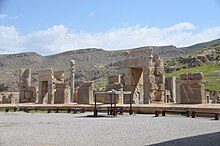
Next to the Apadana, second largest building of the Terrace and the final edifices, is the Throne Hall or the Imperial Army's Hall of Honor (also called the Hundred-Columns Palace). This 70 m2 × 70 m2 (750 sq ft × 750 sq ft) hall was started by Xerxes I and completed by his son Artaxerxes I by the end of the fifth century BC. Its eight stone doorways are decorated on the south and north with reliefs of throne scenes and on the east and west with scenes depicting the king in combat with monsters. Two colossal stone bulls flank the northern portico. The head of one of the bulls now resides in the Oriental Institute in Chicago[50] and a column base from one of the columns in the British Museum.[51]
At the beginning of the reign of Xerxes I, the Throne Hall was used mainly for receptions for military commanders and representatives of all the subject nations of the empire. Later, the Throne Hall served as an imperial museum.
The Tachara Palace
[edit]Tachara, was the exclusive palace of Darius the Great at Persepolis. Only a small portion of the palace was finished under his rule, it was completed after the death of Darius in 486 BC, by his son and successor, Xerxes,[52] who called it a Taçara, which means "winter palace" in Old Persian. It was then used by Artaxerxes I. In the 4th century BC, following his invasion of Iran in 330 BC, Alexander the Great allowed his troops to loot Persepolis. This palace was one of the few structures that escaped destruction in the burning of the complex by Alexander's army, and because of that, Tachara is the most intact building of Persepolis today. It is also the oldest structure at Persepolis. Tachara stands back to back to the Apadana, and is oriented southward.[53]
-
Tachara is the most intact building of Persepolis today.
-
The staircase of Tachara palace at Persepolis
-
The relief of king's battle with devil at Tachara palace, Persepolis
-
Part of the reliefs on the southern stairway of Tachara palace depicting a line of servants bearing animals, food and drinks.
-
Tachara Palace, Persepolis
-
On the structure of Tachara palace
The Hadish Palace
[edit]The Hadish Palace of Xerxes is one of palaces at Persepolis. It's located on the east of the Palace of H (Artaxerxes I). The palace occupies the highest level of terrace and stands on the living rock. The inscriptions of the palace attest that the building was built by order of Xerxes. It covers an area of 2550 square meters (40*55 meters). A double staircase on the west leads to courtyard of the Tachara chateau and another staircase on the northeast connects to courtyard of the Council Hall.
-
The Hadish palace, Persepolis
-
Lotus on the walls of Hadish palace, Persepolis
-
Hadish palace was built by the order of Xerxes
-
Xerxes at the Hadish palace
-
Hadish Palace at Persepolis, 1886
-
The hall of Hadish palace.
Other palaces and structures
[edit]The Council Hall, the Tryplion Hall, the Palaces of D, G, H, storerooms, stables and quarters, the unfinished gateway and a few miscellaneous structures at Persepolis are located near the south-east corner of the terrace, at the foot of the mountain.
-
Huma bird at Persepolis
-
A well-preserved column at Persepolis
-
Reliefs from the Council Hall, Persepolis
-
Part of the treasury, Persepolis
-
The unfinished gate of Persepolis, started by the order of Artaxerxes III, continued by his successors Arses and Darius III.
-
A column head.
Tombs
[edit]
It is commonly accepted that Cyrus the Great was buried in the Tomb of Cyrus in Pasargadae, which is mentioned by Ctesias as his own city. If it is true that the body of Cambyses II was brought home "to the Persians," his burying place must be somewhere beside that of his father. Ctesias assumes that it was the custom for a king to prepare his own tomb during his lifetime. Hence, the kings buried at Naghsh-e Rostam are probably Darius I, Xerxes I, Artaxerxes I and Darius II. Xerxes II, who reigned for a very short time, could scarcely have obtained so splendid a monument, and still less could the usurper Sogdianus. The two completed graves behind the compound at Persepolis would then belong to Artaxerxes II and Artaxerxes III. The unfinished tomb, a kilometer away from the city, is debated to who it belongs.[54]
Ancient texts
[edit]This section contains too many or overly lengthy quotations. (February 2024) |
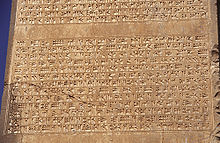

There are a total of 11 existing inscriptions at Persepolis, related to Darius the Great, Xerxes, Artaxerxes II and Artaxerxes III. The relevant passages from ancient scholars on the subject are set out below:
Persepolis was the capital of the Persian kingdom. Alexander described it to the Macedonians as the most hateful of the cities of Asia, and gave it over to his soldiers to plunder, all but the palaces. (2) It was the richest city under the sun, and the private houses had been furnished with every sort of wealth over the years. The Macedonians raced into it, slaughtering all the men whom they met and plundering the residences; many of the houses belonged to the common people and were abundantly supplied with furniture and wearing apparel of every kind...
72 (1) Alexander held games in honor of his victories. He performed costly sacrifices to the gods and entertained his friends bountifully. While they were feasting and the drinking was far advanced, as they began to be drunken, a madness took possession of the minds of the intoxicated guests. (2) At this point, one of the women present, Thais by name and Attic by origin, said that for Alexander it would be the finest of all his feats in Asia if he joined them in a triumphal procession, set fire to the palaces, and permitted women's hands in a minute to extinguish the famed accomplishments of the Persians. (3) This was said to men who were still young and giddy with wine, and so, as would be expected, someone shouted out to form up and to light torches, and urged all to take vengeance for the destruction of the Greek temples. (4) Others took up the cry and said that this was a deed worthy of Alexander alone. When the king had caught fire at their words, all leaped up from their couches and passed the word along to form a victory procession [epinikion komon] in honor of Dionysius.
(5) Promptly, many torches were gathered. Female musicians were present at the banquet, so the king led them all out for the komos to the sound of voices and flutes and pipes, Thais the courtesan leading the whole performance. (6) She was the first, after the king, to hurl her blazing torch into the palace. As the others all did the same, immediately the entire palace area was consumed, so great was the conflagration. It was most remarkable that the impious act of Xerxes, king of the Persians, against the acropolis at Athens should have been repaid in kind after many years by one woman, a citizen of the land which had suffered it, and in sport.
— Diodorus Siculus, 17.70.1–73.2, 17.70 (1)
On the following day, the king called together the leaders of his forces and informed them that "no city was more mischievous to the Greeks than the seat of the ancient kings of Persia [...] by its destruction they ought to offer sacrifice to the spirits of their forefathers."
7 (1) But Alexander's great mental endowments, that noble disposition, in which he surpassed all kings, that intrepidity in encountering dangers, his promptness in forming and carrying out plans, his good faith towards those who submitted to him, merciful treatment of his prisoners, temperance even in lawful and usual pleasures, were sullied by an excessive love of wine. (2) At the very time when his enemy and his rival for a throne was preparing to renew the war, when those whom he had conquered were but lately subdued and were hostile to the new rule, he took part in prolonged banquets at which women were present, not indeed those whom it would be a crime to violate, but, to be sure, harlots who were accustomed to live with armed men with more licence than was fitting.
(3) One of these, Thais by name, herself also drunken, declared that the king would win most favor among all the Greeks, if he should order the palace of the Persians to be set on fire; that this was expected by those whose cities the barbarians had destroyed. (4) When a drunken strumpet had given her opinion on a matter of such moment, one or two, themselves also loaded with wine, agreed. The king, too, more greedy for wine than able to carry it, cried: "Why do we not, then, avenge Greece and apply torches to the city?" (5) All had become heated with wine, and so they arose when drunk to fire the city which they had spared when armed. The king was the first to throw a firebrand upon the palace, then the guests and the servants and courtesans. The palace had been built largely of cedar, which quickly took fire and spread the conflagration widely. (6) When the army, which was encamped not far from the city, saw the fire, thinking it accidental, they rushed to bear aid. (7) But when they came to the vestibule of the palace, they saw the king himself piling on firebrands. Therefore, they left the water which they had brought, and they too began to throw dry wood upon the burning building.
(8) Such was the end of the capital of the entire Orient... .
(10) The Macedonians were ashamed that so renowned a city had been destroyed by their king in a drunken revel; therefore the act was taken as earnest, and they forced themselves to believe that it was right that it should be wiped out in exactly that manner.
— Quintus Curtius Rufus 5.6.1–7.12 5.6 (1)
And did not Alexander the Great have with him Thais, the Athenian hetaira? Cleitarchus speaks of her as having been the cause for the burning of the palace at Persepolis. After Alexander's death, this same Thais was married to Ptolemy, the first king of Egypt.
— Cleitarchus, FGrHist. 137, F. 11 (= Athenaeus 13. 576d-e)
Modern events
[edit]2,500-year celebration
[edit]In 1971, Persepolis was the main staging ground for the 2,500-year celebration of the Persian Empire under the reign of Mohammad Reza Pahlavi, the second and last Shah of the Pahlavi dynasty. It included delegations from foreign nations in an attempt to advance the Iranian culture and history.[56]
The controversy of the Sivand Dam
[edit]Construction of the Sivand Dam, named after the nearby town of Sivand, began on 19 September 2006. Despite 10 years of planning, Iran's Cultural Heritage Organization was not aware of the broad areas of flooding during much of this time,[57] and there is growing concern about the effects the dam will have on the surrounding areas of Persepolis. Activists expressed concern that the dam's placement between the ruins of Pasargadae and Persepolis will flood both. Engineers involved with the construction deny this claim, stating that it is impossible, because both sites sit well above the planned waterline. Of the two sites, Pasargadae is considered the more threatened.[58]
Nowruz Celebrations
[edit]Every year during Nowruz, a large number of people come to Persepolis to celebrate the new year. In 2024, 10,000 people were at Persepolis when Nowruz started.[59][60]
First concert
[edit]In a groundbreaking cultural event, Iranian vocalist Alireza Ghorbani performed the first-ever concert at Persepolis from June 29 to July 1, 2024, and received an overwhelmingly enthusiastic response from attendees.[61][62][63]
Cultural events
[edit]Various events are held in Persepolis every year, including the Shahnameh reading festival and other cultural events.[64][65]
Conservation issues
[edit]The site is also threatened by the presence of lichens that have grown on the surface of the monuments, some of which have eroded intricate carvings and motifs. Some of the lichens are estimated to be around 1,700 years old, and their spread has been attributed to industrialisation, acid rain and the extreme desert climate.[66]
Museums (outside Iran) that display objects from Persepolis
[edit]One bas-relief from Persepolis is in the Fitzwilliam Museum in Cambridge, England.[67] The largest collection of reliefs is at the British Museum, sourced from multiple British travellers who worked in Iran in the 19th century.[68] The Persepolis bull at the Oriental Institute in Chicago is one of the university's most prized treasures, part of the division of finds from the excavations of the 1930s. New York City's Metropolitan Museum and Detroit Institute of Art houses objects from Persepolis,[69] as does the Museum of Archaeology and Anthropology of the University of Pennsylvania.[70] The Museum of Fine Arts of Lyon[71] and the Louvre of Paris hold objects from Persepolis as well. A bas-relief of a soldier that had been looted from the excavations in 1935–36 and later purchased by the Montreal Museum of Fine Arts was repatriated to Iran in 2018, after being offered for sale in London and New York.[72]
-
Forgotten Empire Exhibition, the British Museum
-
Forgotten Empire Exhibition, the British Museum
-
Persepolitan rosette rock relief, kept at the Oriental Institute
-
Achaemenid objects at the Metropolitan Museum of Art, including a bas relief from Persepolis
-
Head of an archer of the royal guard from Hadish palace, Sackler Museum - Harvard University
-
Fragment of wall decoration from Hadish palace, Cleveland Museum of Art
Gallery
[edit]-
A general view of the Persepolis.
-
The tomb of Artaxerxes II at Persepolis
-
Horn-shaped stones at Persepolis.
-
The Queen's Quarters, built by the order of Xerxes. The palace was excavated and rebuilt by Ernst Herzfeld in 1931, and today it is used as a museum and the central office of Persepolis.
-
The use of dovetail joint instead of mortar in gluing stones together.
-
The entrance of Persepolis.
-
Perspolice, Fars Province, Iran
See also
[edit]Notes
[edit]References
[edit]This article incorporates text from a publication now in the public domain: Chisholm, Hugh, ed. (1911). "Persepolis". Encyclopædia Britannica (11th ed.). Cambridge University Press.
- ^ "Location of Persepolis". Google Maps. Archived from the original on 20 April 2023. Retrieved 24 September 2013.
- ^ UNESCO World Heritage Centre (2006). "Pasargadae". Archived from the original on 5 March 2020. Retrieved 26 December 2010.
- ^ a b c Mousavi, Ali, Persepolis: Discovery and Afterlife of a World Wonder, p. 53, 2012, Walter de Gruyter, ISBN 978-1614510338, Google Books Archived 20 April 2023 at the Wayback Machine
- ^ Gates, Charles (2011). Ancient cities: the archaeology of urban life in the ancient Near East and Egypt, Greece and Rome (2nd ed.). London: Routledge. pp. 186–187. ISBN 978-0-203-83057-4.
- ^ Mousavi, Ali (14 March 2012). "VI. Persepolis and the Puzzle of Cuneiform Inscriptions". Persepolis. De Gruyter. pp. 113–122. doi:10.1515/9781614510338.113. ISBN 978-1-61451-028-4.
In this way, the exploration of the ancient ruins at Persepolis proved to be an important key to the development of historical and archaeological studies in the first half of the nineteenth century.
- ^ Bailey, H.W. (1996) "Khotanese Saka Literature", in Ehsan Yarshater (ed), The Cambridge History of Iran, Vol III: The Seleucid, Parthian, and Sasanian Periods, Part 2 (reprint edition), Cambridge: Cambridge University Press, p. 1230.
- ^ a b Michael Woods, Mary B. Woods (2008). Seven Wonders of the Ancient Middle East. Twenty-First Century Books. pp. 26–28. ISBN 978-0822575733.
Persepolis means.
- ^ a b Shahbazi, A. Shapur; Bosworth, C. Edmund (1990). "Capital Cities– Encyclopaedia Iranica". Encyclopædia Iranica. Vol. IV. pp. 768–774. Archived from the original on 10 April 2021. Retrieved 5 August 2018.
- ^ Holland, Tom (2012). In the Shadow of the Sword. Little, Brown. pp. 118–122. ISBN 978-1408700075.
- ^ a b De Silva Figueroa, Garcia (1667), L'Ambassade de D. Garcias de Silva Figueroa en Perse..., translated by De Wicquefort, Abraham, Paris: Louis Billaine, archived from the original on 29 November 2022, retrieved 29 November 2022.
- ^ "Chilminar", Encyclopædia Britannica, vol. II (1st ed.), Edinburgh: Colin Macfarquhar, 1771, pp. 183–184.
- ^ Perrot, Jean (2013). The Palace of Darius at Susa: The Great Royal Residence of Achaemenid Persia. I.B.Tauris. p. 423. ISBN 978-1848856219. Archived from the original on 20 April 2023. Retrieved 25 December 2021.
- ^ a b Garthwaite, Gene R. (2008). The Persians. John Wiley & Sons. p. 50. ISBN 978-1405144001. Archived from the original on 20 April 2023. Retrieved 19 October 2020.
- ^ 2002. Guaitoli. M.T., & Rambaldi, S. Lost Cities from the Ancient World. White Star, spa. (2006 version published by Barnes & Noble. Darius I founded Persepolis in 500 BC as the residence and ceremonial center of his dynasty. p. 164
- ^ "Persepolis". Encyclopedia Britannica. Archived from the original on 10 April 2021. Retrieved 16 October 2017.
- ^ "Persepolis". World History Encyclopedia. Archived from the original on 17 April 2021. Retrieved 16 February 2021.
- ^ "Persepolis". toiran.com. Archived from the original on 5 February 2015. Retrieved 2 January 2015.
- ^ a b Sachau, C. Edward (2004). The Chronology of Ancient Nations. Kessinger Publishing. p. 484. ISBN 978-0-7661-8908-9. p. 127
- ^ Mark, Joshua J. "Alexander the Great & the Burning of Persepolis" Archived 22 April 2021 at the Wayback Machine, 2018, World History Encyclopedia
- ^ Anonimo (1974). Al-Beruni and Persepolis. Vol. 1. Leiden: Peeters Publishers. pp. 137–150. ISBN 978-90-04-03900-1.
{{cite book}}:|journal=ignored (help) - ^ Wiesehöfer 10–11.
- ^ Henkelman 2008:Ch 2.
- ^ "Persepolis". Wondermondo. 13 February 2012. Archived from the original on 28 May 2018. Retrieved 13 February 2012.
- ^ Streck, M.; Miles, G.C. (2012). "Iṣṭak̲h̲r". In P. Bearman; Th. Bianquis; C.E. Bosworth; E. van Donzel; W.P. Heinrichs (eds.). The Encyclopedia of Islam, Second Edition. Brill Online.
- ^ Mousavi, Ali (2012). Persepolis: Discovery and Afterlife of a World Wonder. Walter de Gruyter. ISBN 978-1614510338. Archived from the original on 20 April 2023. Retrieved 19 October 2020.
- ^ Murray, Hugh (1820). Historical account of discoveries and travels in Asia. Edinburgh: A. Constable and Co. p. 15.
- ^ "Principal Navigations, Voyages, Traffiques and Discoveries of the English Nation, by Richard Hakluyt : chapter11". ebooks.adelaide.edu.au. Archived from the original on 3 July 2019. Retrieved 3 July 2019.
- ^ Tuplin, Christopher (2007). Persian Responses: Political and Cultural Interaction with(in) the Achaemenid Empire. ISD LLC. ISBN 978-1910589465. Archived from the original on 20 April 2023. Retrieved 19 October 2020.
- ^ Gouveia, António de (1611). Relaçam em que se tratam as Guerras e Grandes Victorias que alcançou o grande Rei da Persia Xá Abbas do grão Turco Mahometto, e seu filho Amethe: as quais resultaram das Embaixadas, que por mando da Catholica e Real Magestade del Rei D. Felippe segundo de Portugal fizeram alguns Religiosos da ordem dos Ermitas de S. Augustinho à Persia. Lisboa: Pedro Crasbeeck. pp. 31–32.
- ^ C. Wade Meade (1974). Road to Babylon: Development of U.S. Assyriology. Brill Archive. pp. 5–7. ISBN 978-9004038585. Archived from the original on 20 April 2023. Retrieved 19 October 2020.
- ^ M. H. Aminisam (2007). تخت جمشيد (Persepolis). AuthorHouse. pp. 79–81. ISBN 978-1463462529. Archived from the original on 20 April 2023. Retrieved 19 October 2020.
- ^ Ali Mousavi (2012). Persepolis: Discovery and Afterlife of a World Wonder. Walter de Gruyter. pp. 104–107. ISBN 978-1614510284. Archived from the original on 20 April 2023. Retrieved 19 October 2020.
- ^ a b Ali Mousavi, Persepolis in Retrospect: Histories of Discovery and Archaeological Exploration at the ruins of ancient Passch, Ars Orientalis, vol. 32, pp. 209–251, 2002
- ^ "Godard, André – Encyclopaedia Iranica". www.iranicaonline.org. Archived from the original on 25 February 2013. Retrieved 3 July 2019.
- ^ [1] Archived 5 February 2011 at the Wayback Machine Ernst E Herzfeld, A New Inscription of Xerxes from Persepolis, Studies in Ancient Oriental Civilization, vol. 5, 1932
- ^ [2] Archived 5 February 2011 at the Wayback Machine Erich F Schmidt, Persepolis I: Structures, Reliefs, Inscriptions, Oriental Institute Publications, vol. 68, 1953
- ^ [3] Archived 5 February 2011 at the Wayback Machine Erich F Schmidt, Persepolis II: Contents of the Treasury and Other Discoveries, Oriental Institute Publications, vol. 69, 1957
- ^ [4] Archived 5 February 2011 at the Wayback Machine Erich F Schmidt, Persepolis III: The Royal Tombs and Other Monuments, Oriental Institute Publications, vol. 70, 1970
- ^ [5] Archived 5 February 2011 at the Wayback Machine Erich F Schmidt, The Treasury of Persepolis and Other Discoveries in the Homeland of the Achaemenians, Oriental Institute Communications, vol. 21, 1939
- ^ Roaf, Michael; Boardman, John (1980). "A Greek painting at Persepolis". The Journal of Hellenic Studies. 100: 204–206. doi:10.2307/630751. JSTOR 630751. S2CID 161864288. Archived from the original on 16 October 2017. Retrieved 16 October 2017.
- ^ Pierre Briant (2002). From Cyrus to Alexander: A History of the Persian Empire. Eisenbrauns. pp. 256–258. ISBN 978-1575061207. Archived from the original on 20 April 2023. Retrieved 19 October 2020.
- ^ R. W. Ferrier. The Arts of Persia. page 39, image 21
- ^ Penelope Hobhouse (2004). The Gardens of Persia. Kales Press. pp. 177–178. ISBN 978-0967007663. Archived from the original on 20 April 2023. Retrieved 19 October 2020.
- ^ Wright, H. C. (1981). "Ancient Burials of Metal Documents in Stone Boxes: Their Implications for Library History." The Journal of Library History (1974), 16(1), 48–70.
- ^ a b c d e f Zournatzi, Antigoni (2003). "The Apadana Coin Hoards, Darius I, and the West". American Journal of Numismatics. 15: 1–28. JSTOR 43580364.
- ^ Persepolis: discovery and afterlife of a world wonder. 2012. pp. 171–181.
- ^ DPh – Livius. Archived from the original on 11 April 2021. Retrieved 26 March 2020.
- ^ DPh inscription Archived 11 April 2021 at the Wayback Machine, also Photographs of one of the gold plaques Archived 11 April 2021 at the Wayback Machine
- ^ a b Fisher, William Bayne; Gershevitch, I.; Boyle, John Andrew; Yarshater, Ehsan; Frye, Richard Nelson (1968). The Cambridge History of Iran. Cambridge University Press. p. 617. ISBN 978-0521200912. Archived from the original on 20 April 2023. Retrieved 20 November 2018.
- ^ "Oriental Institute Highlights". Oi.uchicago.edu. 19 February 2007. Archived from the original on 14 June 2011. Retrieved 30 December 2012.
- ^ "British Museum collection". Archived from the original on 18 April 2021. Retrieved 3 November 2020.
- ^ Hobhouse, Penelope (2004). The Gardens of Persia. Kales Press. ISBN 978-0-9670076-6-3.
- ^ Mousavi, Ali (19 April 2012). Persepolis: Discovery and Afterlife of a World Wonder. Walter de Gruyter. ISBN 978-1-61451-033-8.
- ^ Potts, Daniel T (2012). A Companion to the Archaeology of the Ancient Near East. John Wiley & Sons. ISBN 978-1405189880. Archived from the original on 20 April 2023. Retrieved 19 October 2020.
- ^ "XPc – Livius". www.livius.org. Archived from the original on 18 April 2021. Retrieved 26 March 2020.
- ^ Amini, Hassan (8 October 2023). "Decadence and Downfall: The World's Most Expensive Party". BBC. Retrieved 12 December 2023.
- ^ Vidal, John (23 December 2004). "Dam is threat to Iran's heritage". The Guardian. Archived from the original on 10 April 2021. Retrieved 10 June 2018.
- ^ Esfandiari, Golnaz. "Iran: Activists Say New Dam Threatens Ancient Historical Sites". Radiofreeeurope/Radioliberty. Retrieved 12 December 2023.
- ^ "۱۰ هزار مسافر نوروزی لحظه تحویل سال را در تخت جمشید جشن گرفتند". خبرگزاری مهر | اخبار ایران و جهان | Mehr News Agency (in Persian). 20 March 2024. Retrieved 30 April 2024.
- ^ "Hafez, Sa'di mausoleums, Persepolis among most visited in Nowruz". IRNA. 30 May 2024.
- ^ "Iranian Singer Alireza Ghorbani Mesmerizes Audience During Concert At Historic Persepolis". Iran Front Page. 2 July 2024. Retrieved 4 July 2024.
- ^ "Alireza Ghorbani's concert at Persepolis extended". Tehran Times. 3 July 2024. Retrieved 4 July 2024.
- ^ "کنسرت علیرضا قربانی در تخت جمشید شیراز". ایسنا (in Persian). 1 July 2024. Retrieved 4 July 2024.
- ^ "جشنواره شاهنامهخوانی در تخت جمشید برگزار میشود". Mehr News Agency (in Persian). 12 March 2024. Retrieved 30 April 2024.
- ^ "(تصاویر) بازدید هیئت فرهنگی چین از تخت جمشید". Fararu. 30 May 2025.
- ^ "The stone-eaters that threaten Iran's ancient Persepolis". France 24. 16 September 2024. Retrieved 16 September 2024.
- ^ A Persepolis Relief in the Fitzwilliam Museum, Cambridge. Richard Nicholls and Michael Roaf. Iran, Vol. 15, (1977), pp. 146–152. Published by: British Institute of Persian Studies.
- ^ Allen, Lindsay (1 January 2013). ""Come Then Ye Classic Thieves of Each Degree": The Social Context of the Persepolis Diaspora in the Early Nineteenth Century". Iran. 51 (1): 207–234. doi:10.1080/05786967.2013.11834730. ISSN 0578-6967. S2CID 193984848.
- ^ Harper, Prudence O., Barbara A. Porter, Oscar White Muscarella, Holly Pittman, and Ira Spar. "Ancient Near Eastern Art." The Metropolitan Museum of Art Bulletin, v. 41, no. 4 (Spring, 1984).
- ^ "Relief – B10301 | Collections – Penn Museum". www.penn.museum. Archived from the original on 15 February 2020. Retrieved 8 September 2020.
- ^ "Découvrir les collections". Musée des Beaux Arts Lyon. Archived from the original on 24 September 2020. Retrieved 8 September 2020.
- ^ Mashberg, Tom (23 July 2018). "Judge Orders Return of Ancient Limestone Relief to Iran". The New York Times. ISSN 0362-4331. Archived from the original on 10 April 2021. Retrieved 3 July 2019.
Further reading
[edit]- Curtis, J. and Tallis, N. (eds). (2005). Forgotten Empire: The World of Ancient Persia. University of California Press. ISBN 0-520-24731-0.
- Devos, Bianca (2018). ""History is repeated": The representation of Persepolis in the Iranian press of the 1930s". Die Welt des Islams. 58 (3): 326–356. doi:10.1163/15700607-00583P03. S2CID 166200185.
- Frye, Richard N. (1974). "Persepolis Again". Journal of Near Eastern Studies. 33 (4): 383–386. doi:10.1086/372376. S2CID 222453940.
- Wilber, Donald Newton. (1989). Persepolis: The Archaeology of Parsa, Seat of the Persian Kings. Darwin Press. Revised edition ISBN 0-87850-062-6.
External links
[edit]- Persepolis – official website (in English and Persian)
- Persepolis at the Ancient History Encyclopedia with timeline, illustrations, and books
- Arthur John Booth. The Discovery and Decipherment of the Trilingual Cuneiform Inscriptions (1902)
- Persepolis Photographs Archived 5 February 2007 at the Wayback Machine and Introduction to the Persian Expedition Archived 15 May 2011 at the Wayback Machine,
- 360 degrees panorama gallery of Persepolis
- Google Maps
- "Persepolis" at Cultural Heritage Organization of Iran
- Greek Art And Arch itecture In Iran (Mentions Ionian work in Persepolis)
- Persepolis: The Magnificent Ancient Capital of the Persian Achaemenid Empire at Amazing Iran Media
- Persepolis
- Lost ancient cities and towns
- Buildings and structures completed in the 6th century BC
- Achaemenid cities
- Archaeological sites in Iran
- Former populated places in Fars province
- Ancient Iranian cities
- Achaemenid architecture
- Book burnings
- Culture of Iran
- Destroyed libraries
- Ruins in Iran
- World Heritage Sites in Iran
- Buildings and structures in Fars province
- Tourist attractions in Fars province
- Persian art
- Establishments in the Achaemenid Empire
- Royal residences in Iran






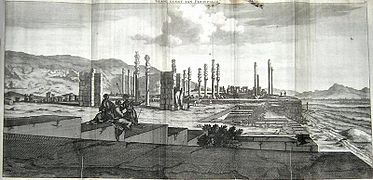





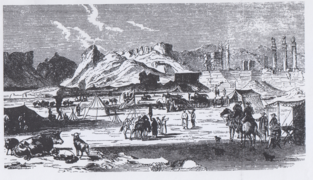


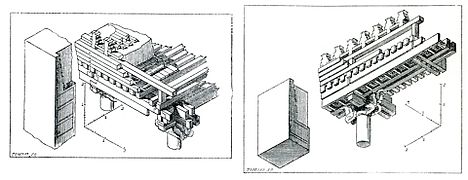

![A bas-relief from the Apadana Palace depicting Delegations including Lydians and Armenians[42] bringing their famous wine to the king.](http://upload.wikimedia.org/wikipedia/commons/thumb/6/68/Persepolis_stairs_of_the_Apadana_relief.jpg/269px-Persepolis_stairs_of_the_Apadana_relief.jpg)






![A bas-relief at Persepolis, representing a symbol in Zoroastrianism for Nowruz.[a]](http://upload.wikimedia.org/wikipedia/commons/thumb/3/36/PersepolisNegareh.jpg/291px-PersepolisNegareh.jpg)
